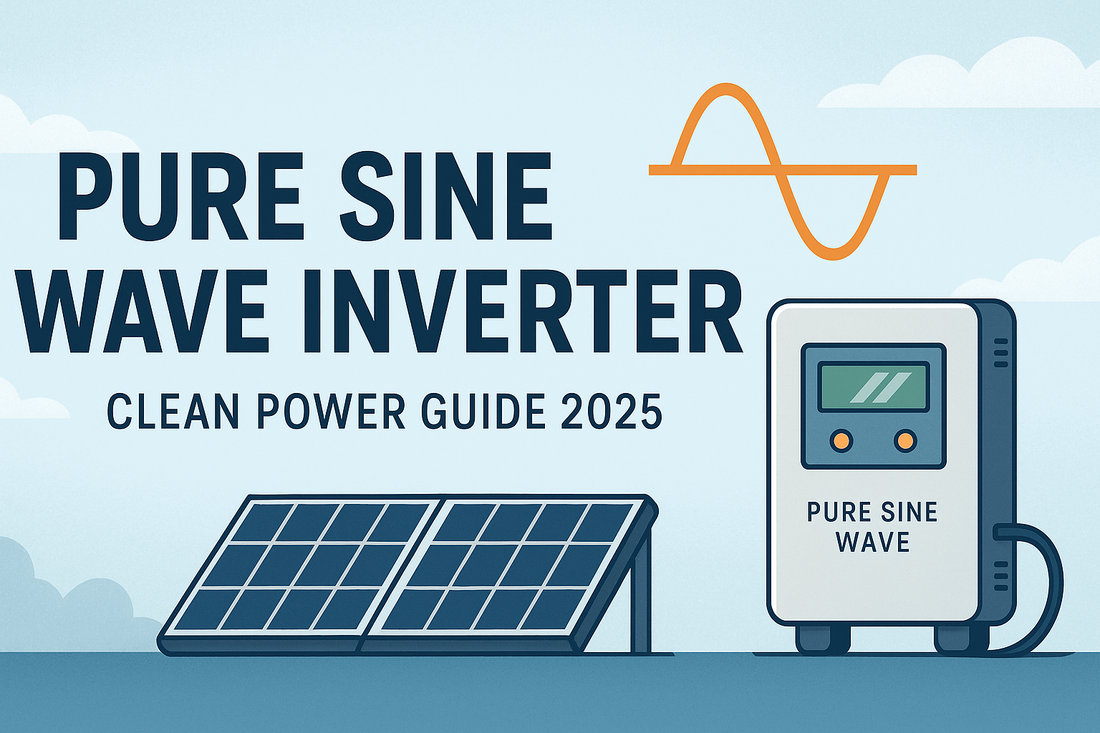A pure sine wave inverter is a critical component in delivering stable and high-quality electrical power to sensitive electronic equipment. In this comprehensive guide, we’ll delve into the fundamentals of pure sine wave inverters examining their operational principles, technical advantages over modified sine wave alternatives, and the specific scenarios in which their use is not just beneficial but essential. Whether you're powering advanced electronics, medical devices, or off-grid systems, understanding the value of clean, true sine wave output is key to protecting your equipment and ensuring optimal performance. Let’s dive in.
What Is a Pure Sine Wave Inverter?
A pure sine wave inverter is an advanced power conversion device that transforms direct current (DC) electricity typically sourced from batteries, solar panels, or other off-grid energy systems into alternating current (AC) electricity with a waveform that closely replicates the smooth, sinusoidal output of utility-grade power. Unlike modified sine wave inverters, which generate a stepped or square-shaped waveform with harmonic distortion, pure sine wave inverters produce a clean, continuous, and stable sine wave. This high-fidelity AC output is essential for running sensitive electronics, precision instruments, and appliances that require consistent voltage and frequency to operate safely and efficiently, without risking performance degradation or equipment damage.
How Does a Pure Sine Wave Inverter Work?
A pure sine wave inverter efficiently converts direct current (DC) into alternating current (AC) by generating a waveform that closely matches the smooth sinusoidal profile of grid-supplied electricity. The internal process involves several key stages:
- DC Input Stage: The inverter receives DC power from sources such as deep-cycle batteries, solar photovoltaic (PV) panels, or other renewable energy systems. It's essential to always select the right inverter size for you home.
- Pulse Width Modulation (PWM) Generation: High-frequency switching transistors typically MOSFETs or IGBTs rapidly alternate the DC signal using Pulse Width Modulation (PWM). This simulates the rising and falling behavior of an AC sine wave.
-
Filtering and Waveform Shaping: The high-frequency PWM signal is routed through low-pass filters composed of capacitors and inductors. These components eliminate switching noise and harmonics, smoothing the waveform into a near-ideal sine wave.
- Voltage Amplification: The smoothed signal is stepped up to the required AC voltage level, often through a high-frequency transformer or boost converter, depending on the inverter architecture.
-
AC Output: The final output is a clean, low-distortion pure sine wave, suitable for powering even the most voltage-sensitive electronics, including medical devices, audio/visual systems, and variable-speed motors.
The performance of a pure sine wave inverter hinges on the precision of its control circuitry and the quality of its components. Premium models incorporate digital signal processors (DSPs) or microcontroller-based controls to deliver highly accurate voltage and frequency regulation, ensuring dependable and interference-free operation across a wide range of applications.
When Do You Need a Pure Sine Wave Inverter?
There are numerous scenarios where a pure sine wave inverter is not just preferred, but essential due to its ability to deliver clean, stable, and low-distortion AC power. Below are key applications where the benefits of pure sine wave output become critical:
-
Sensitive Electronics
Devices such as personal computers, laptops, network servers, and audio/visual systems are highly sensitive to power quality. A pure sine wave inverter ensures proper voltage regulation and minimizes the risk of overheating, malfunction, or reduced lifespan due to waveform irregularities.
-
Medical Equipment
In healthcare environments, maintaining uninterrupted and noise-free power is vital. Pure sine wave inverters are required for powering devices like CPAP machines, oxygen concentrators, defibrillators, and diagnostic imaging systems, where electrical noise or failure can impact patient safety. -
Industrial Equipment
Machinery with microprocessor-based control systems, synchronous motors, and precision sensors depends on pure sine wave input to avoid erratic behavior, system errors, or premature component failure.
-
Audio and Video Production
High-fidelity audio and video production studios use pure sine wave inverters to prevent ground hums, signal interference, and frame disruptions. These systems require clean power for professional-grade performance in recording, editing, and broadcasting environments. -
Telecommunications Infrastructure
Telecom systems such as cell towers, base stations, modems, and network switches demand uninterrupted and low-noise power to ensure data integrity and continuous connectivity, making pure sine wave inverters a necessity for reliable uptime. -
Residential Backup Power
Inverter-based backup systems in homes must support a wide range of appliances, including refrigerators, HVAC systems, LED lighting, and security systems. Pure sine wave inverters ensure compatibility with appliances that incorporate AC motors, digital timers, or inverter-based controls. -
Recreational Vehicles (RVs)
RV enthusiasts rely on pure sine wave inverters to power essential and luxury items from microwaves and televisions to mobile workstations and coffee makers enabling a seamless off-grid experience without compromising equipment performance.
Conclusion
In summary, a pure sine wave inverter delivers clean, stable, and utility-grade AC power, making it the preferred solution for powering a wide range of electronic devices and appliances particularly those sensitive to voltage fluctuations and waveform distortion. When compared to modified sine wave inverters, the pure sine wave variant stands out for its superior compatibility, efficiency, and ability to safeguard equipment from electrical stress or malfunction.
Whether you're supporting critical medical equipment, running sensitive electronics, or managing an off-grid power system, the benefits of pure sine wave technology are clear. Investing in a high-quality pure sine wave inverter is not just about immediate functionality it's a long-term commitment to device safety, operational reliability, and power system efficiency.

